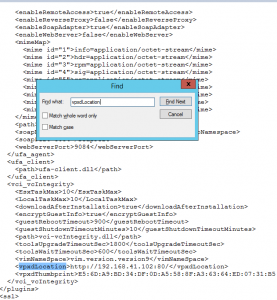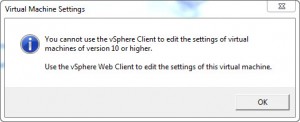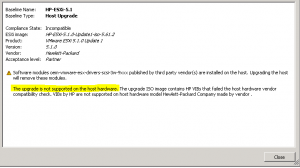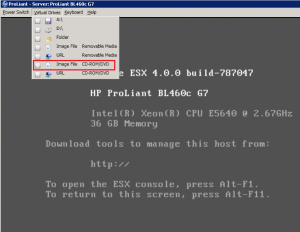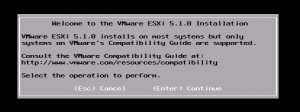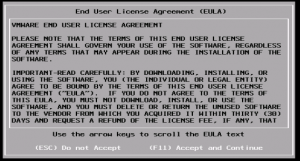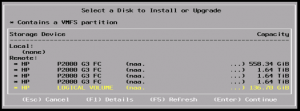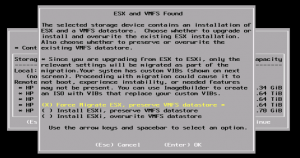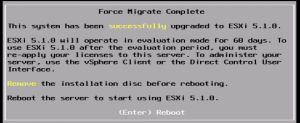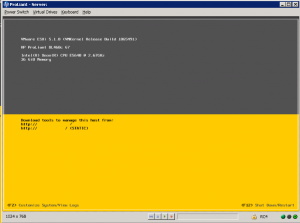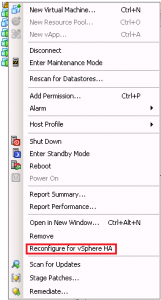There was an error connecting to VMware vSphere Update Manager – [x.x.x.x:443]
After opening up vCenter you may experience the following message:
There was an error connecting to VMware vSphere Update Manager – [x.x.x.x:443]. The request failed because of a connection failure. (Unable to connect to the remote server)
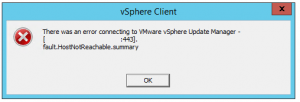
This could occur because you have changed the vCenter IP address, or in my case had re-configured NIC Teaming on the Management Server which momentarily changed the IP address of the Management Server.
Thankfully there is an easy fix:
Log in to the machine on which the Update Manager server component is installed.
Stop the Update Manager service: Click Start > Run, type services.msc, then click OK to open Services. Right-click the VMware Update Manager service and click Stop.

In Windows Explorer, navigate to the Update Manager installation folder. The default path is:
32-bit Windows: C:\Program Files\VMware\Infrastructure\Update Manager
64-bit Windows: C:\Program Files (x86)\VMware\Infrastructure\Update Manager

Open vci-integrity.xml in a text editor, and find this XML tag:
<vpxdLocation>old_vCenter_Server_IP_address</ vpxdLocation>
Replace the old vCenter Server IP address value with the new one.
Save and close the file.
Start the Update Manager service:
Click Start > Run, type services.msc, then click OK to open Services.
Right-click the VMware Update Manager service and click Start.
Source: http://kb.vmware.com/selfservice/microsites/search.do?language=en_US&cmd=displayKC&externalId=1014639
In the vSphere Client, Select Plugins/Manage Plugins. Right-click and Enable the VMware vSphere Update Manager

You’ll now notice the Update Manager tab re-appears!
“You cannot use the vSphere Client to edit the settings of virtual machines of version 10 or higher.”
After using the VMware 5.5 Convertor to perform a physical to virtual migration, I noted the following error when attempting to edit the properties of the VM in vSphere:
“You cannot use the vSphere Client to edit the settings of virtual machines of version 10 or higher.”
Thankfully there is an easy work around!
Confirm the VM is powered-off.
Right-click the VM and remove from inventory:
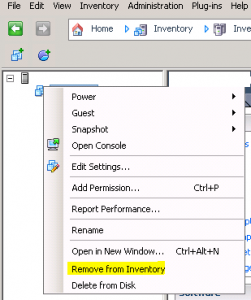
Enable SSH on the host and connect.
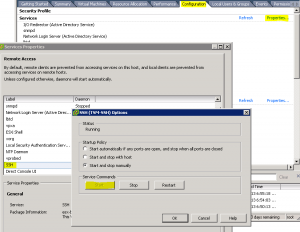
Change directory to your vm:
cd /vmfs/volumes/YOURDATASTORENAMEHERE/YOURVMNAME

Open your VMX file with vi:
vi VMNAME.vmx
![]()
Find the line that says ‘virtualHW.version'(ie.virtualHW.version = “10”) and change to “8”
Hint: Delete 10, type “i” to start editing, put 8 between the quotes, then Esc key when done, “:wq” to save changes (:q! to exit without saving).
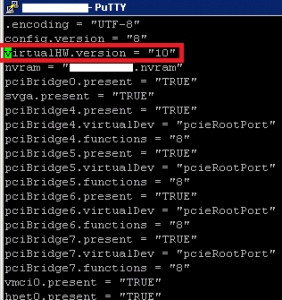
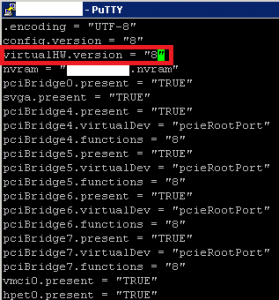
Re-register the VM in Vsphere: vim-cmd solo/registervm /vmfs/volumes/YOURDATASTORENAMEHERE/YOURVMDIRECTORY/YOURVM.vmx
You should now be able to edit your VM!
Could not allocate space for object dbo.VPX_TEXT_ARRAY in VIM_VCDB
I recently completed a vCenter 5.1 update for a customer and notice a few days later that the vCenter service had stopped. Restarted and logged in to find the following error: “A general system error occurred” “Could not allocate space for object dbo.VPX_TEXT_ARRAY” in VIM_VCDB, etc.

Checked the disk that the DB was located on and confirmed there was plenty of space. Turns out the default limit for SQL Express had been reached. I followed the following article to resolve this issue: http://kb.vmware.com/selfservice/microsites/search.do?cmd=displayKC&docType=kc&docTypeID=DT_KB_1_1&externalId=1025914
First, I stopped the vCenter Service.

Expanded the VIM_VCDB DB, selected Tables & Opened the dbo-VPX_PARAMETER table.
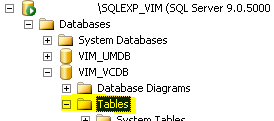
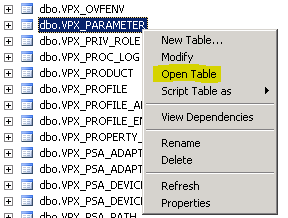
Modify event.maxAge to 30, and modify the event.maxAgeEnabled value to true.
![]()
Modify task.maxAge to 30, and modify the task.maxAgeEnabled value to true.
![]()
Scroll down on the left, expand Programmability, Stored Procedures. Right-click on dbo.cleanup_events_tasks_proc, select Excute then OK on the following screen to run the produce.

Finally once this has completed, shrink the database & restart the vCenter Service
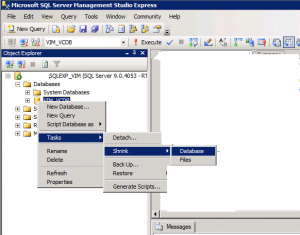
Insufficient resources to satisfy HA
After building or converting a new VM, you may find the following error when you power it on:
![]()
This is due to Admission Control in VMware calculating your current host utilization and determining you wouldn’t have enough resources available to run your VMs in case of a host failure, based on the settings specified. Ideally, you should add the adjust host/vm resources to ensure that your Admission Control can be met. If not, Admission Control can be adjusted if required by right-clicking on your Cluster and selecting “Edit Settings:
Next, select vSphere HA and either a) Disable Admission Control or b) Adjust your Admission Control Policy:

Missing Remote Console option in vSphere Web Client
One of the great features in ESXi 5.x is the vSphere Web Client. It is very feature rich and is nice to have a web client front end for remote support, etc. We recently received a call from a customers external vendor who couldn’t bring up the web console. I checked their permissions and confirmed they had access to the VM they needed to work on. They could perform virtual machine functions but there was simply no option available for remote console.
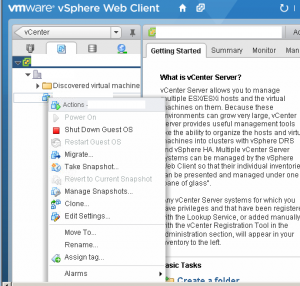
Remoted to their system and noted that the Client Integration Plugin was not loaded.

Downloaded and installed, logged in and confirmed Remote Console was now available and operational.
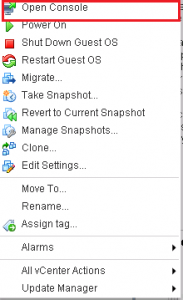
VMware Scan/Stage/Remediate Patching Fails
I was recently patching an ESXi 5.1 host received the following error when attempted to scan, stage or remediate the host:
![]()
None of the rest of the hosts in the cluster had any issues, so I assumed the issue was with the host. I then went and checked the Update Manager logs for further info. These logs are located under: C:\Users\All Users\VMware\VMware Update Manager\Logs. In the vmware-vum-server-log4cpp.log file in this folder. I search for error or warning in the text editor to look for potential issues. This led me to the following error: Platform Configuration Error: /usr/sbin/esxupdate returned no results, exit status: 1
![]()
I then searched Google and came across the following article for VMware: http://kb.vmware.com/selfservice/microsites/search.do?language=en_US&cmd=displayKC&externalId=2014538
Followed the steps listed in the KB:
To check if the vmsyslogd service is running, run the command:
ps | grep vmsyslogd
If there is no output, the service is not running.
To start the vmsyslogd service, run the command:
/usr/lib/vmware/vmsyslog/bin/vmsyslogd
To reload vmsyslogd , run the command:
esxcli system syslog reload
To verify that the vmsyslogd service is running, re-run the command:
ps | grep vmsyslogd
I discovered the following error in the syslog output after running esxcli system syslog reload command listed above:
![]()
From there, changed the path location for Syslog on the host, selected ok and was then able to scan(this was the actual issue)/stage/remediate the host!

vCenter Install – Failed to create database users.
Recently installing vCenter for a customer and received the following error when installing vCenter’s SQL Component:
“Error 32010. Failed to create database users. There can be several reasons for this failure. For more information, see the vmMSSWLCmd.log file in the system temporary folder”
Open up your %temp% path and look for the VMMSSQLCmd.log file to see the cause of the failure. In this case: Password validation failed. The password does not meet Windows policy requirements because it is not complex enough.

Re-ran setup and selected a more complex password – install now completes successfully!
vCenter Service won’t start/Failed to create http proxy
I recently had a customer who’s vCenter service would not start on their management server. The Event 1000 error showed: “Failed to intialize VMware VirtualCenter. Shutting down…” Not very helpful!

Next, I checked the vpxd log files: %ALLUSERSPROFILE%\Application Data\VMware\VMware VirtualCenter\Logs\. In there I noticed the following error: [VpxdReverseProxy] Failed to create http proxy: An attempt was made to access a socket in a way forbidden by its access permissions. This indicated that something was using one of the vCenter ports (By default 80,443,902).
The next step for this was to find out what was using one of those ports. For that, we use the netstat command: netstat -bano > C:\netstat.txt (I will generally output this to text file as it makes it easier to search).
![]()
Search the output file for the ports VMware Ports listed above (or the non-standard ports you may have configured).

To check what application is related to the PID, open Task Manager and add PID to the view (View, Select Columns)
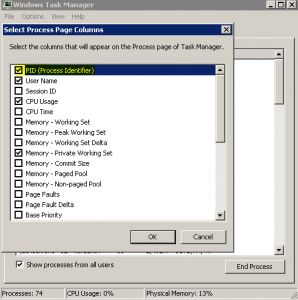
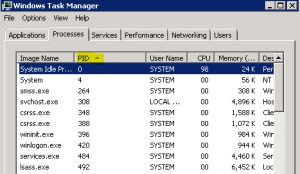
At this stage I had a pretty good idea what was using it. Jumped into IIS and sure enough, somebody had started the Default Website running on Port 80. Stopped the website and restarted the vCenter Service with no further issues
ESXi 5.1 Manual/Force Upgrade
One of the great features of vCenter 5.1 is the ability to upgrade older 4.x ESX/ESXi hosts to 5.1 from within Upgrade Manager. This being said, I have had several recent deployments where this has not being an option due to perceived incompatibilities between installation media (both branded & unbranded) and the host. The other issue I have found is that the Update Manager method doesn’t automatically recognize the ESX/ESXi partition. Even after installing the latest host firmware(which I would highly recommended) and confirming it is on the compatibility list of supported hardware for ESXi 5.1 I still receive “The upgrade is not supported on the host hardware. The upgrade ISO image contains HP (or other vendor) VIBs that failed the host hardware vendor compatibility check. VIBs by HP are not supported on host hardware model Hewlett-Packard Company made by vendor.”
It is possible to customize your install image and add/remove VIBs as required but I have found the easiest way to resolve this is by doing a manual upgrade. This can be done be done directly from the host, or my preferred method – Out-of-Band Management, Dell DRAC, HP iLO, IBM AMM, etc.
Mount your VMware ESXi 5.1 media (or insert CD) and restart host.
You will see the ESXI 5.1 Splash Screen which will continue to load the various modules
After all the modules load (Approx. 5-10min) you will be presented with the following install screen. Hit enter on your keyboard to continue past this screen & F11 to accept the EULA on the following.
The installer then scans through available hardware and you are faced Disk selection option. Select your ESX/ESXi install volume and press Enter to continue.
You are then faced with upgrade/install options. IMPORTANT: Do NOT select overwrite VMFS datastore unless you are prepared to lose all of your Virtual Machines or really enjoy restoring all of your data from backups… Select Force Migrate ESX, preserve VMFS datastore and Enter to continue. On the following screen you are asked to confirm. Hit F11 if you are happy to proceed
Depending on your hardware, after approximately 10-15min you should see a message indicating “Force Migrate Complete.” Select enter to reboot.
After couple of reboots you should find yourself at the VMware ESXi 5.1 splash screen and be able to access your host via vCenter 5.1.
vCenter “Host currently has no management network redundancy”
We recently had an IBM Blade environment where the HA Heartbeat/Management network were sharing the same NIC due to hardware constraints. This will cause an alert warning in vCenter.
Ideally, you would be best to add a second NIC to the management VMkernel Port, either with NIC teaming or in standby. If you are aware of this but would like to suppress the message anyway, take the following steps:
Right-click on your HA cluster in your vSphere Client, select “Edit Settings”

Click on vSphere HA & select “Advanced Options”, add the following line:
Option: das.ignoreRedundantNetWarning
Value: true
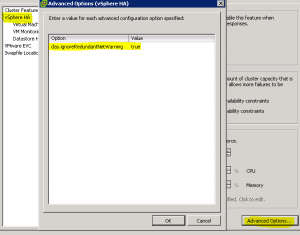
Click Ok twice, right the host with the error and select “Reconfigure for vSphere HA” and after a few moments the error should disappear.


